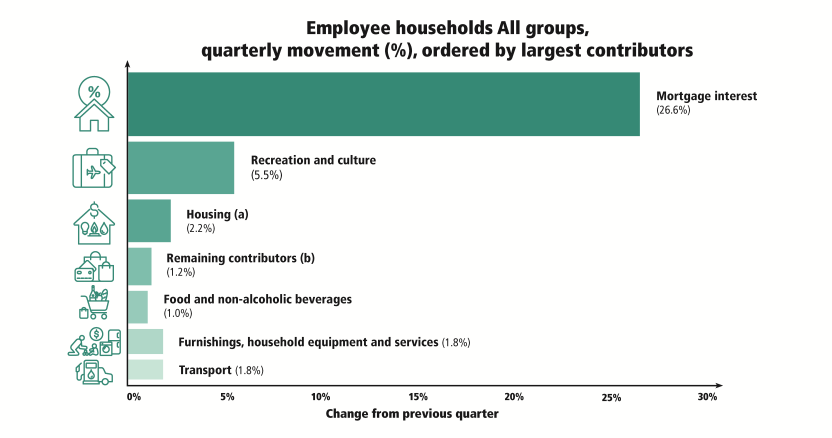Selected Living Cost Indexes (LCIs) by household type and Consumer Price Index (CPI), Australia, annual movement (%)
[["Dec-86","Mar-87","Jun-87","Sep-87","Dec-87","Mar-88","Jun-88","Sep-88","Dec-88","Mar-89","Jun-89","Sep-89","Dec-89","Mar-90","Jun-90","Sep-90","Dec-90","Mar-91","Jun-91","Sep-91","Dec-91","Mar-92","Jun-92","Sep-92","Dec-92","Mar-93","Jun-93","Sep-93","Dec-93","Mar-94","Jun-94","Sep-94","Dec-94","Mar-95","Jun-95","Sep-95","Dec-95","Mar-96","Jun-96","Sep-96","Dec-96","Mar-97","Jun-97","Sep-97","Dec-97","Mar-98","Jun-98","Sep-98","Dec-98","Mar-99","Jun-99","Sep-99","Dec-99","Mar-00","Jun-00","Sep-00","Dec-00","Mar-01","Jun-01","Sep-01","Dec-01","Mar-02","Jun-02","Sep-02","Dec-02","Mar-03","Jun-03","Sep-03","Dec-03","Mar-04","Jun-04","Sep-04","Dec-04","Mar-05","Jun-05","Sep-05","Dec-05","Mar-06","Jun-06","Sep-06","Dec-06","Mar-07","Jun-07","Sep-07","Dec-07","Mar-08","Jun-08","Sep-08","Dec-08","Mar-09","Jun-09","Sep-09","Dec-09","Mar-10","Jun-10","Sep-10","Dec-10","Mar-11","Jun-11","Sep-11","Dec-11","Mar-12","Jun-12","Sep-12","Dec-12","Mar-13","Jun-13","Sep-13","Dec-13","Mar-14","Jun-14","Sep-14","Dec-14","Mar-15","Jun-15","Sep-15","Dec-15","Mar-16","Jun-16","Sep-16","Dec-16","Mar-17","Jun-17","Sep-17","Dec-17","Mar-18","Jun-18","Sep-18","Dec-18","Mar-19","Jun-19","Sep-19","Dec-19","Mar-20","Jun-20","Sep-20","Dec-20","Mar-21","Jun-21","Sep-21","Dec-21","Mar-22","Jun-22","Sep-22","Dec-22"],[[null],[null],[null],[null],[null],[null],[null],[null],[null],[null],[null],[null],[null],[null],[null],[null],[null],[null],[null],[null],[null],[null],[null],[null],[null],[null],[null],[null],[null],[null],[null],[null],[null],[null],[null],[null],[null],[null],[null],[null],[null],[null],[null],[null],[null],[null],[null],[null],[null],[null],[null],[null],[null],[null],[null],[null],[null],[null],[null],[null],[null],[null],[null],[null],[null],[null],[null],[null],[null],[null],[null],[null],[null],[null],[null],[null],[null],[null],[null],[null],[null],[null],[null],[null],[null],[null],[4.7000000000000002],[5.0999999999999996],[4.2999999999999998],[3.5],[2.2000000000000002],[2],[2.6000000000000001],[2.7999999999999998],[3.7999999999999998],[3.7999999999999998],[4],[4.7000000000000002],[4.5],[4.2000000000000002],[3.2000000000000002],[1.3999999999999999],[1.1000000000000001],[1.8999999999999999],[2.2000000000000002],[2.5],[2.2999999999999998],[2],[2.3999999999999999],[3],[3.1000000000000001],[2.1000000000000001],[1.7],[0.90000000000000002],[1],[1],[1.3],[1.1000000000000001],[0.90000000000000002],[1.5],[1.7],[2.3999999999999999],[2],[2],[2.2999999999999998],[2.2999999999999998],[2.5],[2.2000000000000002],[2.1000000000000001],[1.6000000000000001],[1.8999999999999999],[1.8999999999999999],[1.8],[2.3999999999999999],[0.40000000000000002],[0.90000000000000002],[0.69999999999999996],[0.59999999999999998],[2.8999999999999999],[2.7000000000000002],[3],[4.5999999999999996],[5],[6.4000000000000004],[7.4000000000000004]],[[null],[null],[null],[null],[null],[null],[null],[null],[null],[null],[null],[null],[null],[null],[null],[null],[null],[null],[null],[null],[null],[null],[null],[null],[null],[null],[null],[null],[null],[null],[null],[null],[null],[null],[null],[null],[null],[null],[null],[null],[null],[null],[null],[null],[null],[null],[null],[null],[null],[null],[null],[null],[1.2],[2.6000000000000001],[3.5],[6.2000000000000002],[6.4000000000000004],[6.5],[5.5999999999999996],[2.1000000000000001],[2.1000000000000001],[1.8999999999999999],[2.2000000000000002],[3.2000000000000002],[3.2999999999999998],[3.7000000000000002],[3],[2.6000000000000001],[2.5],[2.5],[3.2999999999999998],[3.1000000000000001],[3.3999999999999999],[2.7000000000000002],[2.8999999999999999],[3.6000000000000001],[3.1000000000000001],[3.6000000000000001],[4.5],[4.5],[4.2999999999999998],[3.5],[3.1000000000000001],[2.7999999999999998],[3.5],[5],[5.7999999999999998],[6.2000000000000002],[4.5],[2.3999999999999999],[-0.80000000000000004],[-1.1000000000000001],[0.29999999999999999],[2],[4.5],[4.7000000000000002],[4.5],[4.7999999999999998],[4.5],[3.8999999999999999],[3.2999999999999998],[1.2],[0.69999999999999996],[0.69999999999999996],[0.69999999999999996],[1],[0.69999999999999996],[0.90000000000000002],[1.3],[2.1000000000000001],[2.2999999999999998],[1.8999999999999999],[1.6000000000000001],[0.90000000000000002],[0.90000000000000002],[0.69999999999999996],[1.1000000000000001],[1.1000000000000001],[1],[1.2],[1],[1.5],[1.3],[1.5],[2],[2],[2.2999999999999998],[2],[1.8999999999999999],[1.3999999999999999],[1.6000000000000001],[1.3],[1],[1.1000000000000001],[-2.1000000000000001],[-0.90000000000000002],[-0.5],[0],[3.2999999999999998],[2.6000000000000001],[2.6000000000000001],[3.7999999999999998],[4.5999999999999996],[6.7000000000000002],[9.3000000000000007]],[[null],[null],[null],[null],[null],[null],[null],[null],[null],[null],[null],[null],[null],[null],[null],[null],[null],[null],[null],[null],[null],[null],[null],[null],[null],[null],[null],[null],[null],[null],[null],[null],[null],[null],[null],[null],[null],[null],[null],[null],[null],[null],[null],[null],[null],[null],[null],[null],[null],[null],[null],[null],[1.5],[2.6000000000000001],[2.8999999999999999],[5.7000000000000002],[5.7000000000000002],[6.0999999999999996],[6.2000000000000002],[2.7999999999999998],[3.7999999999999998],[3.3999999999999999],[3.2000000000000002],[3.6000000000000001],[3],[3.6000000000000001],[2.7999999999999998],[2.5],[2.3999999999999999],[2],[2.3999999999999999],[2.2000000000000002],[2.5],[2.2000000000000002],[2.3999999999999999],[3.2999999999999998],[3],[3.3999999999999999],[5.0999999999999996],[5.2999999999999998],[4.5],[3],[2.1000000000000001],[1.8999999999999999],[2.6000000000000001],[4.5],[4.2999999999999998],[4.7000000000000002],[4],[3.5],[2.7999999999999998],[2.3999999999999999],[3.1000000000000001],[3.2000000000000002],[3.2999999999999998],[3],[3.2000000000000002],[4],[4.5],[4.2999999999999998],[3.1000000000000001],[1.1000000000000001],[0.69999999999999996],[2],[2.3999999999999999],[2.7999999999999998],[2.6000000000000001],[2],[2.5],[3],[3.1000000000000001],[1.8999999999999999],[1.2],[0.80000000000000004],[0.90000000000000002],[0.90000000000000002],[1.2],[0.80000000000000004],[0.69999999999999996],[1.5],[1.6000000000000001],[2.3999999999999999],[2],[1.7],[2.1000000000000001],[2.1000000000000001],[2.2000000000000002],[2.2999999999999998],[2],[1.3999999999999999],[1.8999999999999999],[1.7],[1.8],[2.3999999999999999],[1],[0.90000000000000002],[0.40000000000000002],[0.5],[2.2999999999999998],[2.6000000000000001],[3.3999999999999999],[4.9000000000000004],[5.2000000000000002],[6.5],[7.2999999999999998]],[[null],[null],[null],[null],[null],[null],[null],[null],[null],[null],[null],[null],[null],[null],[null],[null],[null],[null],[null],[null],[null],[null],[null],[null],[null],[null],[null],[null],[null],[null],[null],[null],[null],[null],[null],[null],[null],[null],[null],[null],[null],[null],[null],[null],[null],[null],[null],[null],[null],[null],[null],[null],[1.8999999999999999],[2.8999999999999999],[3.3999999999999999],[5.9000000000000004],[5.9000000000000004],[6],[5.9000000000000004],[2.7000000000000002],[3],[2.5],[2.2000000000000002],[2.8999999999999999],[2.8999999999999999],[3.7000000000000002],[2.7000000000000002],[2.6000000000000001],[2.2999999999999998],[2],[2.7000000000000002],[2.5],[2.7999999999999998],[2.2000000000000002],[2.7000000000000002],[3.3999999999999999],[3.2000000000000002],[3.6000000000000001],[4.5999999999999996],[4.9000000000000004],[4.2000000000000002],[3.2999999999999998],[2.7999999999999998],[2.3999999999999999],[3.2000000000000002],[4.7999999999999998],[5.0999999999999996],[5.4000000000000004],[4.4000000000000004],[3.5],[1.8999999999999999],[1.7],[2.2999999999999998],[2.6000000000000001],[4.2000000000000002],[4.4000000000000004],[4.5],[5.0999999999999996],[4.5999999999999996],[4.0999999999999996],[3.2999999999999998],[1.6000000000000001],[1.2],[1.8999999999999999],[2],[2.2999999999999998],[2.2000000000000002],[2],[2.5],[3.1000000000000001],[3.1000000000000001],[2.2999999999999998],[1.8999999999999999],[1],[1.1000000000000001],[1],[1.3999999999999999],[1.1000000000000001],[1.1000000000000001],[1.6000000000000001],[1.8],[2.5],[2],[2.1000000000000001],[2.3999999999999999],[2.3999999999999999],[2.7000000000000002],[2.2000000000000002],[2.1000000000000001],[1.6000000000000001],[1.8999999999999999],[1.8999999999999999],[1.8999999999999999],[2.3999999999999999],[0],[0.80000000000000004],[0.80000000000000004],[0.69999999999999996],[3.5],[2.7000000000000002],[2.7000000000000002],[4.2999999999999998],[4.7999999999999998],[6.2999999999999998],[7.4000000000000004]],[[null],[null],[null],[null],[null],[null],[null],[null],[null],[null],[null],[null],[null],[null],[null],[null],[null],[null],[null],[null],[null],[null],[null],[null],[null],[null],[null],[null],[null],[null],[null],[null],[null],[null],[null],[null],[null],[null],[null],[null],[null],[null],[null],[null],[null],[null],[null],[null],[null],[null],[null],[null],[1],[2.3999999999999999],[2.7999999999999998],[5.7000000000000002],[5.5],[6.0999999999999996],[6],[2.2999999999999998],[3.3999999999999999],[3.2999999999999998],[3.2000000000000002],[3.7999999999999998],[3.2999999999999998],[3.6000000000000001],[2.7999999999999998],[2.2999999999999998],[2.2999999999999998],[1.7],[2.2000000000000002],[2.2000000000000002],[2.1000000000000001],[2.2999999999999998],[2.2000000000000002],[3.1000000000000001],[2.7000000000000002],[3.2000000000000002],[4.5999999999999996],[4.7000000000000002],[4.0999999999999996],[2.5],[1.8999999999999999],[1.6000000000000001],[2.5],[4.2000000000000002],[4.2000000000000002],[4.7999999999999998],[3.5],[2.8999999999999999],[2],[1.5],[2.7000000000000002],[2.8999999999999999],[3],[2.8999999999999999],[2.7999999999999998],[3.5],[4],[3.7999999999999998],[3.2000000000000002],[1.3],[0.59999999999999998],[1.5],[1.8999999999999999],[2.2999999999999998],[2.2000000000000002],[2],[2.6000000000000001],[2.8999999999999999],[3.2000000000000002],[2.2000000000000002],[1.5],[1.3],[1.2],[1.2],[1.6000000000000001],[1.1000000000000001],[1.1000000000000001],[1.5],[1.3999999999999999],[2],[1.8],[1.6000000000000001],[1.6000000000000001],[1.8],[2],[2.2999999999999998],[2.2000000000000002],[1.6000000000000001],[2],[1.8999999999999999],[1.8999999999999999],[2.2999999999999998],[1.1000000000000001],[0.69999999999999996],[0.80000000000000004],[1.3],[2.7000000000000002],[2.8999999999999999],[3.2999999999999998],[4.4000000000000004],[5],[6.2999999999999998],[7.5999999999999996]],[[9.5999999999999996],[9.4000000000000004],[9.3000000000000007],[8.3000000000000007],[7.2000000000000002],[6.7999999999999998],[7.2000000000000002],[7.2999999999999998],[7.5999999999999996],[6.7999999999999998],[7.5],[8],[7.7999999999999998],[8.6999999999999993],[7.7000000000000002],[6.0999999999999996],[6.9000000000000004],[4.7999999999999998],[3.2999999999999998],[3.1000000000000001],[1.5],[1.7],[1.2],[0.80000000000000004],[0.29999999999999999],[1.2],[1.8],[2.2000000000000002],[1.8],[1.5],[1.8],[2],[2.6000000000000001],[3.7000000000000002],[4.5],[5.0999999999999996],[5.0999999999999996],[3.7999999999999998],[3.1000000000000001],[2.1000000000000001],[1.5],[1.3999999999999999],[0.29999999999999999],[-0.40000000000000002],[-0.29999999999999999],[-0.10000000000000001],[0.69999999999999996],[1.3999999999999999],[1.5],[1.2],[1],[1.8],[1.8999999999999999],[2.7999999999999998],[3.1000000000000001],[6.0999999999999996],[5.7999999999999998],[6],[6.0999999999999996],[2.5],[3.1000000000000001],[3],[2.7999999999999998],[3.2000000000000002],[2.8999999999999999],[3.2999999999999998],[2.6000000000000001],[2.6000000000000001],[2.3999999999999999],[2],[2.5],[2.2999999999999998],[2.5],[2.3999999999999999],[2.5],[3.1000000000000001],[2.7999999999999998],[2.8999999999999999],[4],[4],[3.2999999999999998],[2.5],[2.1000000000000001],[1.8],[2.8999999999999999],[4.2999999999999998],[4.4000000000000004],[5],[3.7000000000000002],[2.3999999999999999],[1.3999999999999999],[1.2],[2.1000000000000001],[2.8999999999999999],[3.1000000000000001],[2.8999999999999999],[2.7999999999999998],[3.2999999999999998],[3.5],[3.3999999999999999],[3],[1.6000000000000001],[1.2],[2],[2.2000000000000002],[2.5],[2.3999999999999999],[2.2000000000000002],[2.7000000000000002],[2.8999999999999999],[3],[2.2999999999999998],[1.7],[1.3],[1.5],[1.5],[1.7],[1.3],[1],[1.3],[1.5],[2.1000000000000001],[1.8999999999999999],[1.8],[1.8999999999999999],[1.8999999999999999],[2.1000000000000001],[1.8999999999999999],[1.8],[1.3],[1.6000000000000001],[1.7],[1.8],[2.2000000000000002],[-0.29999999999999999],[0.69999999999999996],[0.90000000000000002],[1.1000000000000001],[3.7999999999999998],[3],[3.5],[5.0999999999999996],[6.0999999999999996],[7.2999999999999998],[7.7999999999999998]]]
[]
[{"value":"0","axis_id":"0","axis_title":"","axis_units":"","tooltip_units":"","table_units":"","axis_min":null,"axis_max":null,"tick_interval":"4","precision":"-1","data_unit_prefix":"","data_unit_suffix":"","reverse_axis":false}][{"value":"0","axis_id":"0","axis_title":"Percentage change (%)","axis_units":"","tooltip_units":"(% change)","table_units":"(% change)","axis_min":null,"axis_max":null,"tick_interval":null,"precision":"-1","data_unit_prefix":"","data_unit_suffix":"","reverse_axis":false}]